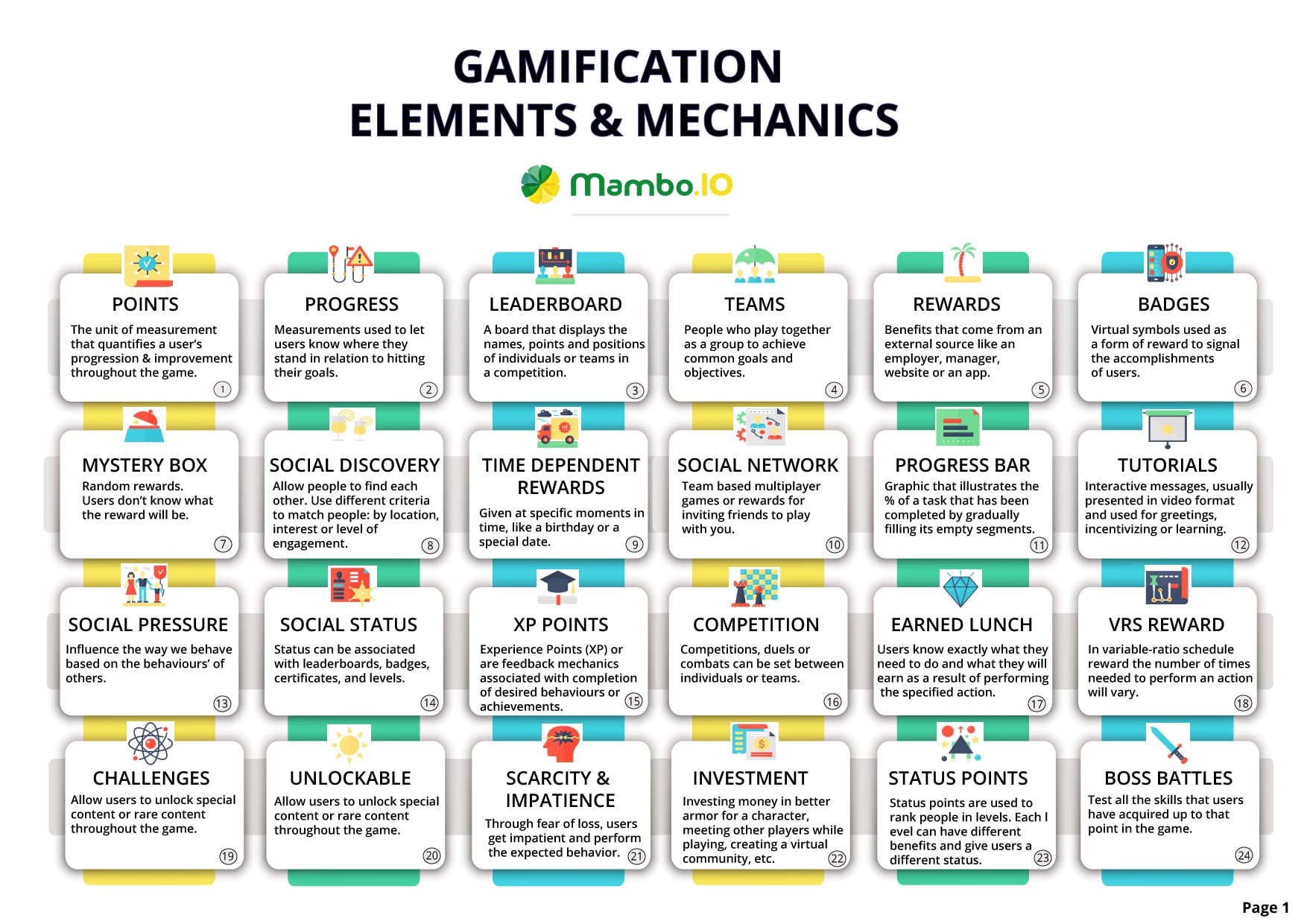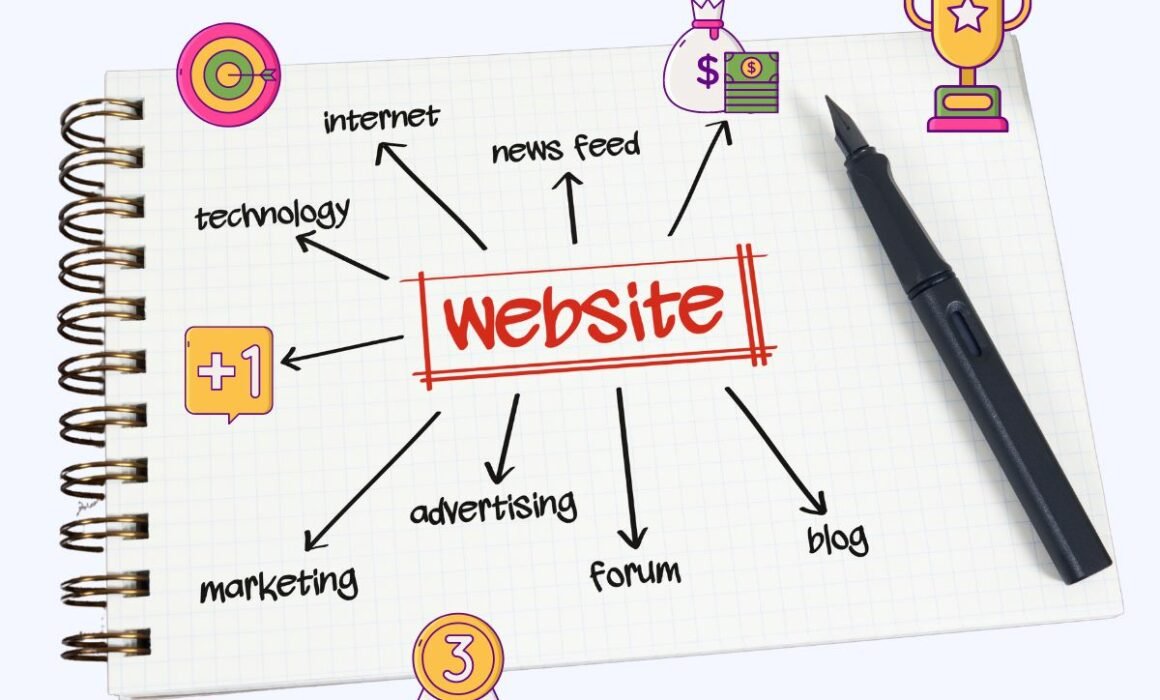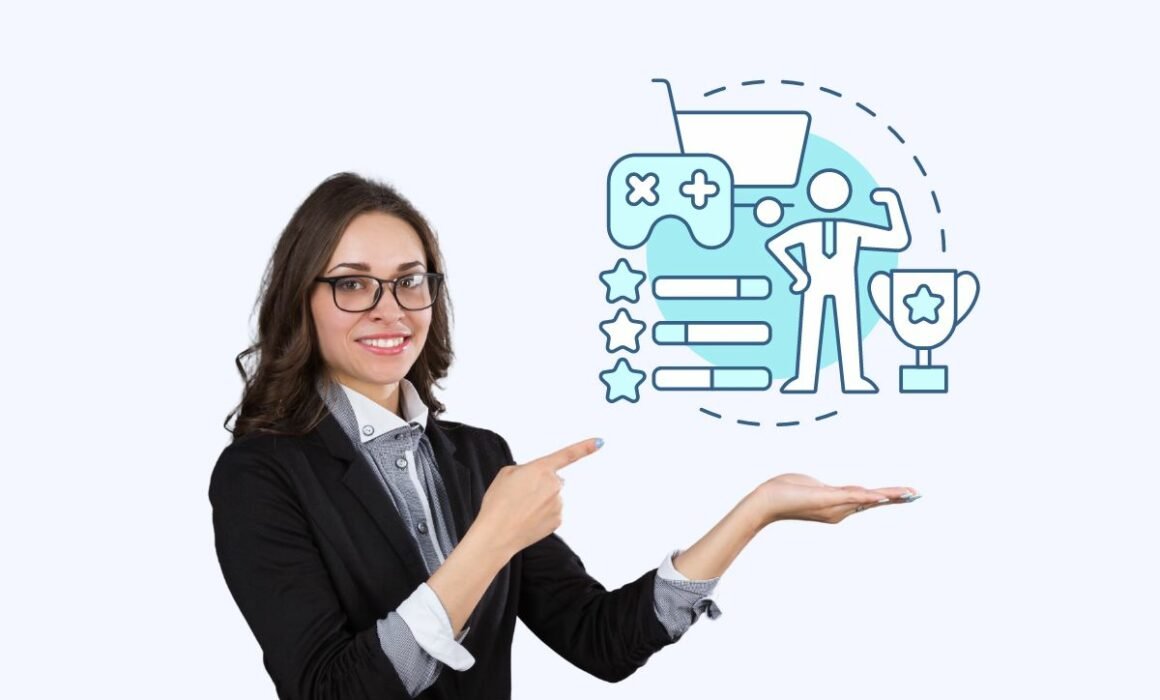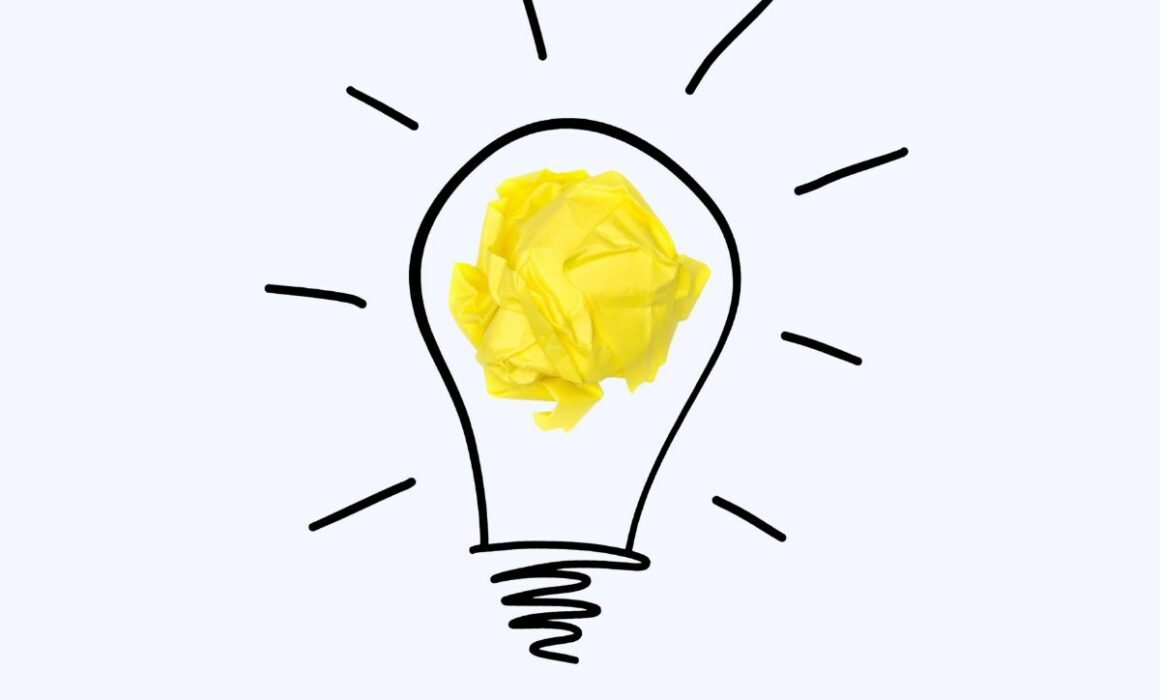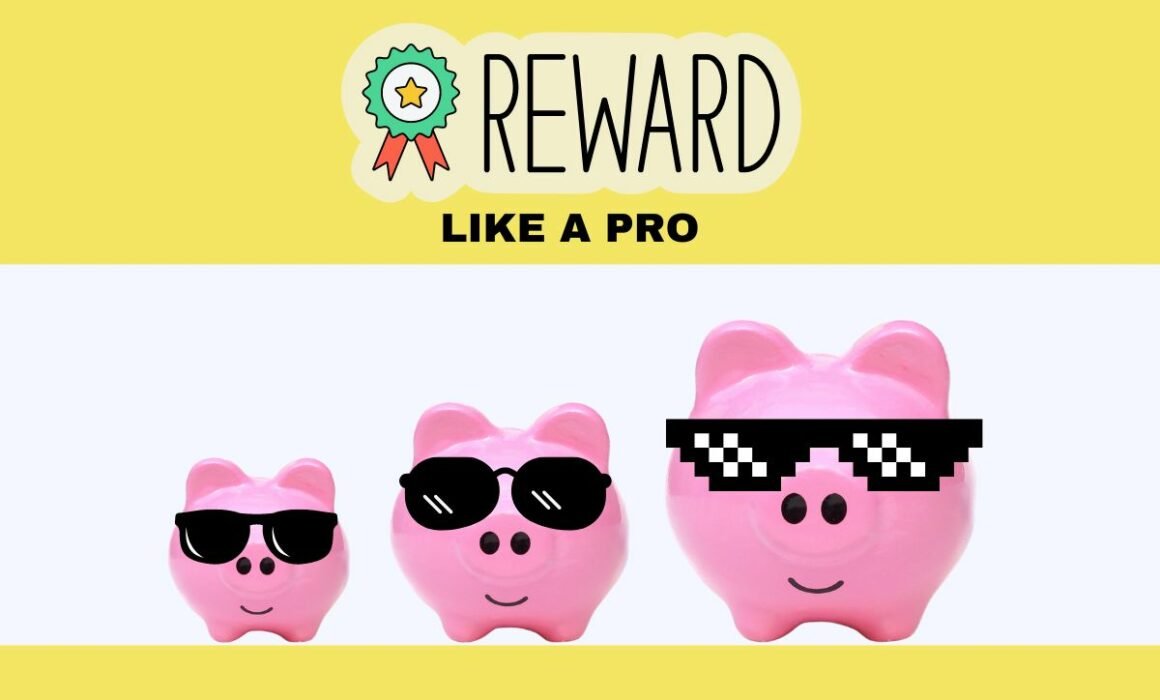13 Gamification Tools To Boost Engagement And Product Adoption
Tired of the sound of crickets when you look at customer engagement metrics? Say goodbye to the yawn-inducing methods of yesterday. Gamification tools are here to sprinkle a bit of magic dust on those numbers.
Think of gamification tools as the espresso shot your business strategy desperately needs. No, we’re not transforming your office into a life-sized chessboard. We’re talking about clever, game-inspired tactics. They amp up customer enthusiasm, loyalty, and a sense of community faster than you can say “Checkmate!”
“Great,” you say, “but where’s the starting line?” Don’t you worry – gamification tools are your shortcut to engagement glory.
The right gamification tools are your secret weapon. They transform how customers discover your products, build loyalty, and become superfans spreading the word. This isn’t just theory. We’re going to dive into the best tools out there. We’ll show you exactly how to ignite that sense of purpose and community that drives growth.
So, get those points, badges, and leaderboards ready – it’s game on.
Download your free
“Gamification Guide”
Get your PDF now and start transforming your approach to digital engagement!
Table of Contents
- Which tools of gamification you can integrate into systems?
- Why gamification tools are a must-have for product teams
- Getting started with gamification tools
- Types of gamification tools: choosing the right fit
- The bottomline: gamification is your product’s superpower
- FAQs
- Machine Learning In Finance: 12 Essential Applications
- How To Create Interactive Compliance Training For Bank Employees
- How Fintech Apps Are Using Gamification To Increase User Engagement
- Top Gamification Companies for Employee & Customer Engagement
Which tools of gamification you can integrate into systems?
Carefully choosing and integrating gamification tools is key to boosting engagement and driving product adoption. They need to align perfectly with your business goals. Let’s first understand the fundamental behaviours gamification taps into.
#1. Behaviours
At the heart of gamification lies a deep understanding of what makes us tick. Gamification taps into our innate competitiveness. It appeals to our desire for rewards. It also plays on our fear of missing out. Through these motivators, gamification greatly increases engagement. Gamification caters to various personalities and learning styles. It can nurture communities of introverts. Simultaneously, it can improve learning for those less conscientious team members.
Let’s first understand the fundamental behaviours or innate human motivators gamification taps into:
- Competitiveness: Gamification plays on our competitive spirit through leaderboards and challenges, pushing us to be the best. It also makes use of our universal desire for rewards, enticing users with points, badges, and other goodies.
- FOMO No More: By creating limited-time offers and exclusive achievements, gamification can instill a thrilling sense of urgency and excitement. This would encourage frequent engagement.
- Personality Power: Research shows that gamified systems work well for introverts. These can cater to a variety of personalities. And for those struggling with focus and organisation, gamification can provide structure and support better behaviours.
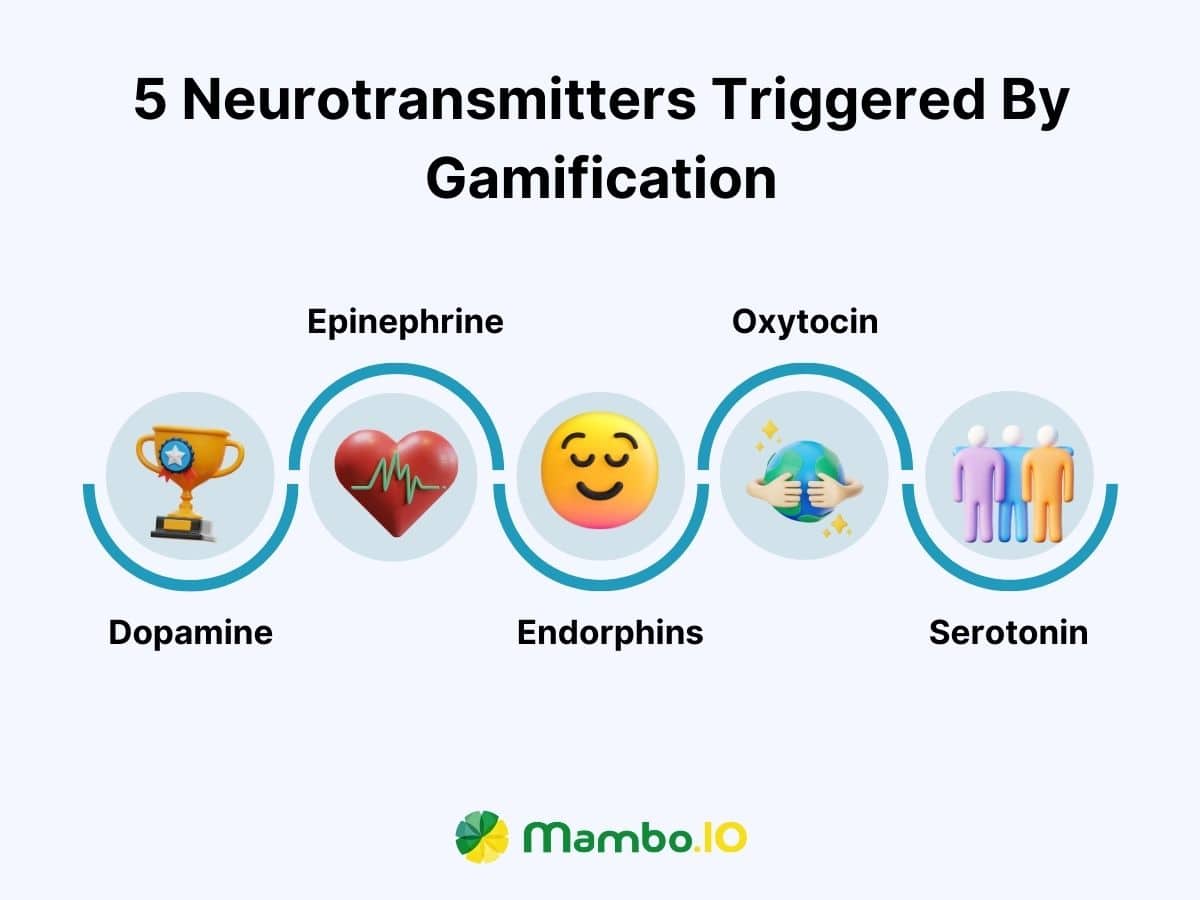
#2. Points, badges, and leaderboards
The trifecta of gamification, these elements are like the Harry, Ron, and Hermione of engaging users. Points keep the score, badges celebrate milestones and leaderboards? Well, they stir up the competitive spirit like nothing else. Ingeniously woven into your gamification strategy, they transform routine interactions into quests for glory.
#3. Points: the currency of progress
Points are the lifeblood of your gamified system. Think of them as the currency of progress. Users rack up points by completing tasks, taking actions, or simply engaging with your product. Points can unlock cool new features or grant access to exclusive content. They can even be redeemed for virtual goodies. The possibilities are endless.
#4. Badges: wear your wins with pride
Badges are those coveted symbols of accomplishment. They mark major milestones, recognise specific skills, and make users feel like champions. Displaying badges on user profiles adds a touch of personalisation. It lets everyone know, “Hey, I’ve got this!”
#5. Leaderboards: fueling the competitive spirit
Leaderboards put the spotlight on top performers, adding a dash of friendly competition. Seeing their names in lights motivates users to keep pushing, aiming for that coveted top spot. Don’t be afraid to get creative. Try daily, weekly, or monthly leaderboards to keep the competition fresh and exciting.
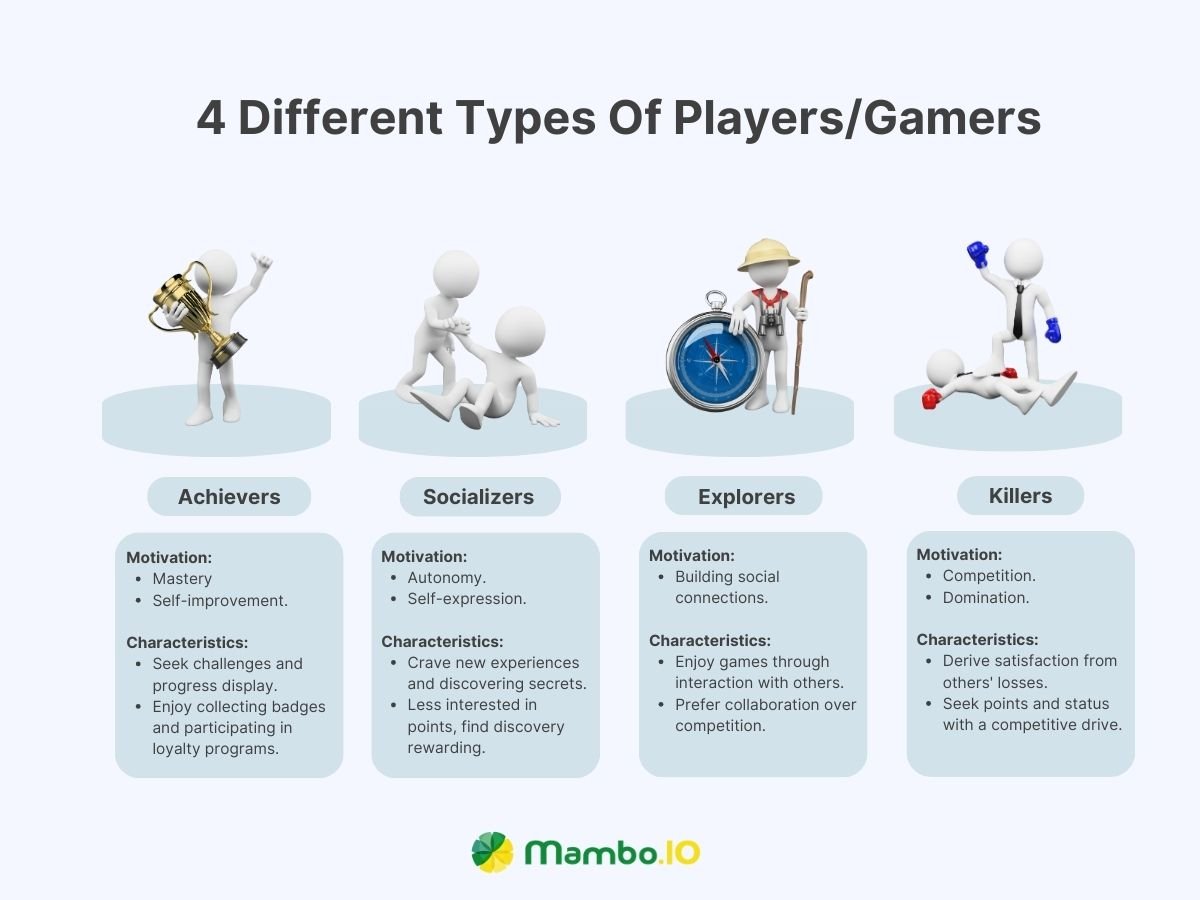
#6. Challenges and missions
Integrating challenges and missions into your digital products can significantly elevate user engagement and foster a sense of achievement. Here’s a closer look at how you can implement these gamification tools effectively:
Progression missions
Think of these as a guided tour of your product. Users follow a set path, unlocking new skills and features as they go. This is great for onboarding and step-by-step learning.
Random missions
Love a bit of spontaneity? Random missions let users tackle tasks in whatever order they choose, offering flexibility and personalisation.
#7. Challenge power
Break down big missions into smaller, bite-sized challenges. These mini-tasks give users a sense of accomplishment as they work towards the ultimate goal. And the best part? Make those challenges fun and interactive! Users will keep coming back for more, especially if there’s a continuous stream of new challenges to conquer.
#8. Rewards and incentives
Think beyond just handing out prizes. Rewards are about building a whole environment where users feel valued, motivated, and eager to keep engaging. Let’s dive into some strategic reward types:
Fixed action rewards: the path to predictable wins
These are your classic “do this, get that” rewards (think loyalty programs). They create a clear roadmap for users: complete specific actions, earn predictable rewards, build trust and encourage consistent participation.
Random rewards: a sprinkle of surprise
Imagine finding a shiny coin on the ground – that’s the feeling of a random reward. Sprinkle these into your gamification strategy after certain actions. That touch of the unexpected adds excitement and keeps users coming back for more.
Sudden rewards: bonus motivation boost
Think of these like surprise coupons popping up. Sudden, unexpected rewards delight users and can really amp up loyalty and engagement.
Rolling rewards: the game of chance
Want to keep users hooked? Rolling rewards give them a chance to win after certain actions, like a virtual lottery or prize wheel. There’s a thrill to that anticipation.
Rewards from friends: building community
Encourage users to give rewards to each other. This fosters camaraderie, strengthens social connections, and creates excitement about your product.
Prize pacing: scarcity creates value
Ever seen those limited-time offers? By carefully spacing out larger rewards, you increase that feeling of scarcity and make the prize more desirable.
#9. Peer-to-peer recognition: building a culture of appreciation
Gamification isn’t just about winning flashy prizes. This is about strategically fostering an environment where users feel consistently valued, encouraged, and enthusiastic to engage. Essentially, product teams flourish when there’s a strong sense of connection and appreciation.
Mambo.io’s peer-to-peer recognition features make it easy to foster that environment. Here’s how:
- Customised appreciation: Go beyond generic rewards. Let users create custom rewards, points, or messages to show their colleagues some love in a meaningful way.
- Gift of gratitude: Users can send each other virtual gifts or written shoutouts for a quick pick-me-up or to celebrate wins.
- Recognition that lasts: Allow users to view their history of received praise. This creates a lasting record of their accomplishments and the positive impact they have on others.
#10. Coupon system: rewards with real-world impact
Bridge the gap between those digital points and real-world satisfaction with a strategic coupon system. Reward users with discounts, free shipping, exclusive swag – the possibilities are endless! This creates a powerful incentive for engagement that users can see and feel. Here’s how to implement a coupon system that gets results:
- Make it rewarding: Don’t just offer small discounts. Create a sense of value that makes users eager to earn those coupons.
- Security is key: Use advanced validation (like Mambo’s secure systems) to prevent fraud and ensure rewards are earned fairly.
- Align with your goals: Tie coupons to specific actions or milestones that support your product objectives.
- Integrate seamlessly: Make coupons a natural part of your existing points or rewards system for a smooth user experience.
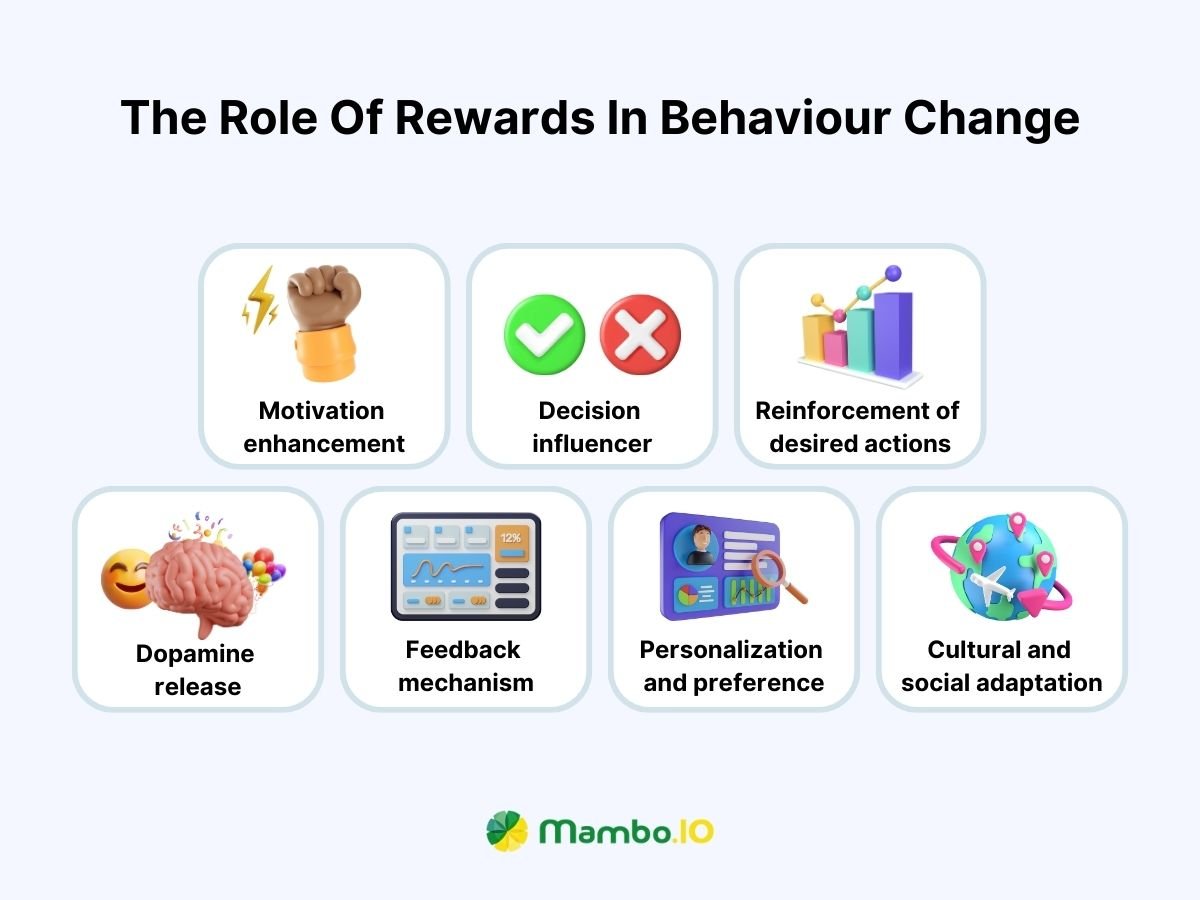
#11. Tags: unlock the power of personalisation
Tags are a powerful tool, allowing you to customise your gamification strategy and deliver targeted experiences. By grouping related game mechanics with tags, you personalise what each user sees, ensuring every interaction is relevant and engaging. This leads to higher participation. It also fosters a greater sense of connection to your product. In addition, it can lead to a simplified, more efficient way to manage your gamification system.
Here’s how you can leverage tags to enhance your gamification strategy:
#12. Personalisation is key
- Tailored for each user: Automatically adapt game mechanics based on a user’s role, department, interests – you name it! Mambo’s personalisation tags give each user a custom experience.
- Relevance = engagement: When users see challenges, rewards, and content that’s actually relevant to them, they’re way more likely to get hooked and stay engaged.
#13. Grouping for Efficiency
- Streamline your strategy: Group related game mechanics with tags. Need to deploy your onboarding program? Retrieve all the relevant elements with a single click.
- Targeted competition: Create segmented leaderboards or activity streams using tags – keep the competition focused and fair.
Download your free
“108 Gamification Elements and Mechanics”
Get your cheat sheet and have a quick reference at your fingertips!
Why gamification tools are a must-have for product teams
Gaining a true understanding of the effect of gamification tools can provide your product team with a distinct competitive edge. It is worth emphasising that these tools are the key to unlocking innovation, boosting user engagement, and accelerating product adoption. Let’s examine why this may be the case:
Gamification tools boost user engagement
It is worth noting that gamification taps into fundamental human motivations, undoubtedly driving user engagement through various means.
Leveraging data-driven insights
Evidently, analysing scoreboards, leaderboards, and other gamification data can provide valuable insights into what truly motivates your users. Interestingly, you can then refine your strategies accordingly based on those insights.
Embracing continuous improvement
A key advantage here is that gamification is not static. User feedback is your secret weapon. Use it to fine-tune your onboarding process, communication, and incentives. Do that, and you’ll see engagement stay consistently high.
Harnessing the power of big data
Interestingly, it is possible to combine gamification insights with big data. Arguably, doing so presents an opportunity to personalize user experiences in a more impactful way. Additionally, it allows you to potentially predict user behaviors with greater accuracy over time. Obviously, leveraging these capabilities enables you to tailor engagement strategies more effectively. It is conceivable that this data-driven approach can meaningfully elevate engagement levels.
Gamification tools enhance data insights
It’s worth emphasising that gamification provides more than just fun and games. Evidently, it generates a wealth of valuable data that allows you to truly understand your audience at a deeper level. Interestingly, here’s how you can leverage that data to your advantage:
Predictive analytics and AI-driven user analysis
Conceivably, AI and predictive analytics can reveal important trends within your gamification system. Those insights empower you to tailor user experiences that directly align with individual preferences and behaviours. This would result in maximum relevance and impact.
Strategic gamification techniques
Say goodbye to stagnant progress. Data-driven milestones keep users motivated by showing them clear goals. Personalised challenges add another layer of fun, pushing them to improve at their own pace. Then, top it all off with mentorship guided by real user insights. This would then lead you to a recipe for consistent progress on the right track. Desirably, leveraging these techniques can pay dividends.
Gamification tools accelerate product adoption
Getting users to rapidly and effectively adopt your product can certainly be a challenge. Remarkably, however, gamification has the potential to transform that very challenge into an engaging, rewarding experience. Consider this potential roadmap:
- Know your goals, know your users: It goes without saying that you must clearly define your gamification goals. These include increased engagement, a faster learning curve, and higher feature adoption. Then, with authority born of experience, determine what truly motivates your users. Are they driven primarily by competition, achievement, or a desire to learn?
- Make learning fun: Design fun activities to guide users through your product. Think interactive tutorials, challenges that unlock features, and rewards for getting creative! This makes learning a blast.
- Data is your guide: Want to know if your gamification strategy is working? You need to track key metrics. Things like time to value, activation rate, and customer engagement scores will give you the full picture. Analyse this data to pinpoint which specific gamification elements are driving success, then strategically double down on what works.
Gamification tools improve feedback loops
It is worth emphasising that feedback loops are arguably the backbone of truly effective gamification. Evidently, they serve the critical function of indicating to users whether they are on the right track. They also motivate them and offer valuable guidance. The main types of feedback loops include:
- Positive feedback loops: These reinforce desired behaviours. They also foster continuous improvement over time through mechanisms like rewards, points, badges, and social validation from peers.
- Negative feedback loops: These can help discourage undesired behaviours and maintain overall game balance via penalties, time limits, obstacles, and other deterrents.
- Immediate feedback: Giving instant responses to user actions can enhance the learning experience and satisfaction levels in a meaningful way.
- Delayed feedback: Build excitement with timed feedback or rewards at key milestones. This keeps users hooked and eager to reach the next level.

Getting started with gamification tools
Integrating gamification into your systems requires a structured approach. This ensures its effectiveness and alignment with your business or learning objectives. Here’s a step-by-step guide to getting started with gamification tools:
Step 1: Define success
- Focus on your goals: What specific problem are you solving (increasing engagement, onboarding, etc.)?
- Set SMART targets: Make your objectives specific, measurable, achievable, relevant to your business, and time-bound.
Step 2: Choose your tools wisely
- Align with objectives: Select mechanics (badges, leaderboards, etc.) that directly support your goals.
- Keep it simple: Start with clear, easy-to-understand elements. Complexity can come later!
- Be realistic: Consider your budget, resources, and your team’s skills when choosing mechanics.
Step 3: Start small, scale smart
- Test and learn: Begin with one or two gamification elements. Track their impact and gather feedback before expanding.
- Data-driven growth: Analyze metrics and user responses to iteratively refine and strategically expand your gamification efforts.
Types of gamification tools: choosing the right fit
The world of gamification offers two main paths: comprehensive platforms and custom-built solutions. Understanding the pros and cons of each will help you make the strategic choice for your product’s needs.
Gamification platforms: the fast-track option
Packed with features
These platforms come loaded with leaderboards, badges, quizzes, rewards, and more, all ready to implement.
User-friendly
Intuitive interfaces and pre-made templates make getting started a breeze.
Versatile and scalable
Platforms like Mambo.io and Bunchball adapt to various goals (engagement, training, etc.) and can grow alongside your business.
Factors to consider
- Limited customisation options compared to custom-built solutions
- May not be suitable for highly complex or niche requirements
Best for
-
- Companies looking for a rapid gamification deployment
- Businesses with limited technical expertise or resources
- Organisations seeking a cost-effective solution for their gamification needs
Custom-built solutions: for highly specific needs
Tailored experience
If you require a system uniquely designed around your product, goals, and users, this is the way to go.
Factors to Consider
- Custom solutions often require a higher investment or budget
- The timeline is longer, which makes this inconvenient if speed is essential
- How important are truly unique mechanics and a highly tailored experience?
Best for
- Enterprises with complex gamification requirements
- Companies with specific integration needs or niche use cases
The bottomline: gamification is your product’s superpower
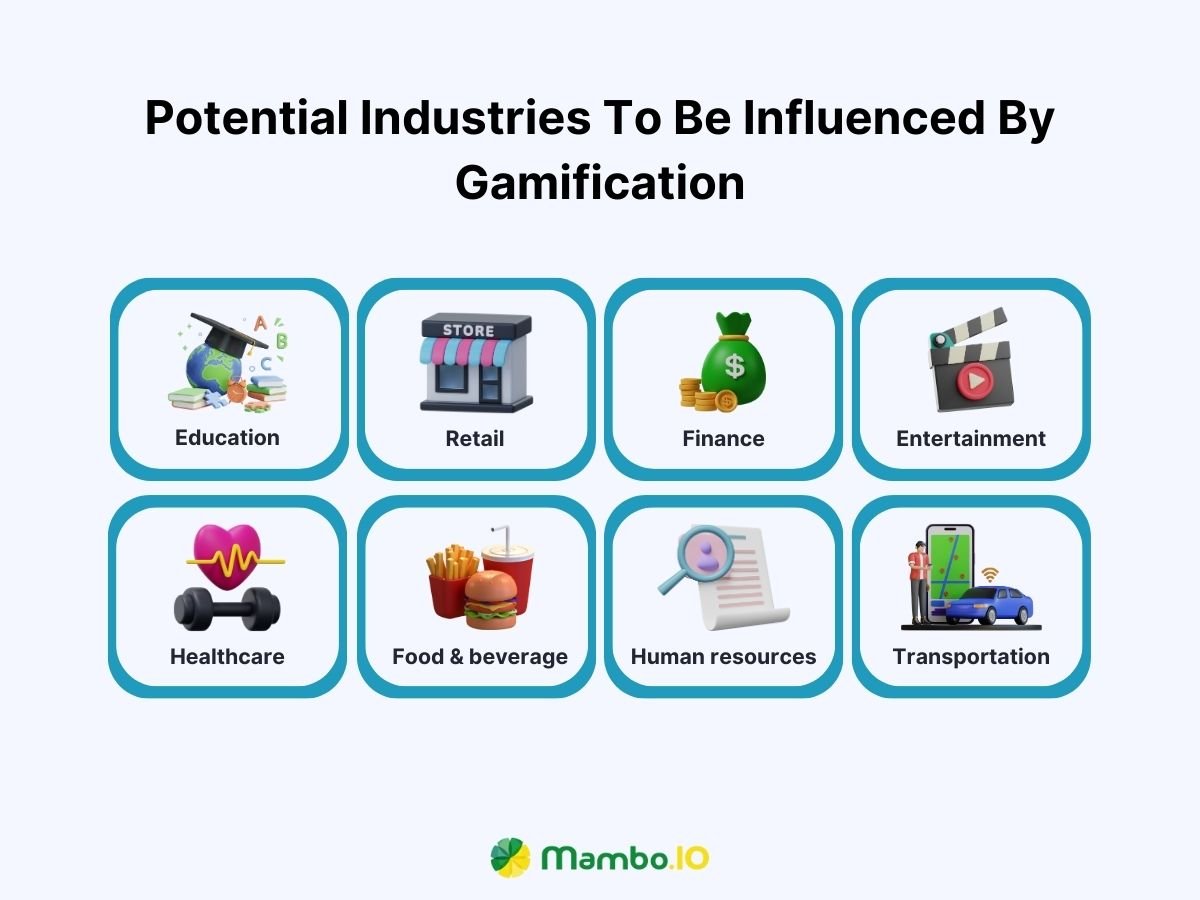
Gamification isn’t just about fun and games. It’s about giving you the tools to create experiences that truly resonate with users. By understanding what motivates them, you can:
- Keep them hooked: Design interactions that make users want to come back for more.
- Unlock valuable insights: Discover how users engage with your product, guiding improvements.
- Drive rapid adoption: Turn onboarding into an exciting journey that gets users invested.
Ready to see the difference gamification can make? Mambo.io puts intuitive gamification tools at your fingertips. Get user-friendly tools, insightful data, and seamless integration with your product.
FAQs
Q: What are the key benefits of using gamification tools in product management?
A: Gamification tools supercharge your product by:
- Boosting user engagement – keep them coming back for more!
- Accelerating product adoption – turn onboarding into an exciting journey.
- Unlocking deeper user insights – understand how users interact with your product.
- Enhancing feedback loops – guide users and get valuable data to improve your product.
Q: How can gamification tools help me achieve my product goals?
A: Gamification tools align directly with key product management goals. It makes users more engaged, helps them discover awesome features, and simplifies the onboarding process. Platforms like Mambo.io make implementation easy and provide data to optimise your strategy.
Q: What should I consider when choosing gamification tools?
A: Think about:
- Your specific goals: What problems are you trying to solve?
- Your target audience: What motivates your users?
- Customisation needs: How unique does your gamification experience need to be?
- Budget and resources: What can you realistically invest in implementation?
Q: How can Mambo.io help me create engaging user experiences?
A: Mambo.io is designed for product teams. It offers:
- User-friendly tools and customisable features to tailor the experience.
- Pre-built templates to get you started quickly.
- Data-driven insights to optimise your gamification strategy over time.
Q: What types of gamification tools are available?
A: There are two main paths:
- Gamification platforms (like Mambo.io): Offer quick implementation, pre-made features, and scalability.
- Custom-built solutions: Provide maximum control and unique branding but generally require more time and investment.
Latest Posts
Machine Learning In Finance: 12 Essential Applications
The impact of machine learning on finance is significant. Thanks to this technology, financial institutions are now equipped to make efficient decisions. Through the analysis of data sets, machine learning […]
How To Create Interactive Compliance Training For Bank Employees
Banking compliance training isn’t just another task. It’s the stage where everything else performs. Banks must navigate a myriad of regulations and laws. After all, this is a trust-driven, high-stakes […]
How Fintech Apps Are Using Gamification To Increase User Engagement
Discover how gamification in fintech is revolutionizing financial engagement, making banking fun & boosting user loyalty.


